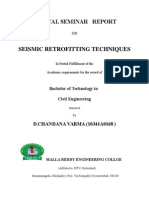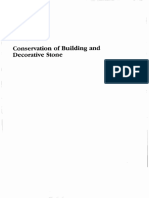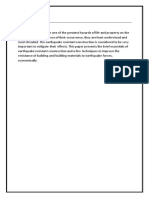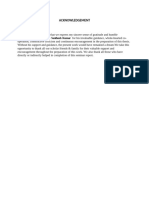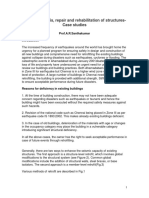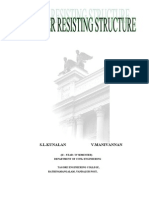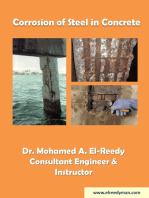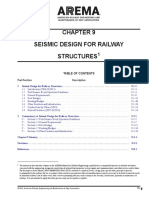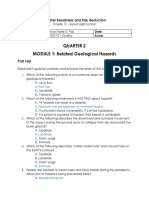Untitled
Untitled
Uploaded by
Aj NatividadCopyright:
Available Formats
Untitled
Untitled
Uploaded by
Aj NatividadCopyright
Available Formats
Share this document
Did you find this document useful?
Is this content inappropriate?
Copyright:
Available Formats
Untitled
Untitled
Uploaded by
Aj NatividadCopyright:
Available Formats
1. What is the difference between “earthquake proof” and “earthquake resilient”?
Earthquakes are the most dangerous natural disaster, capable of causing catastrophe in all aspects of
structures. It creates horizontal pressure on building which causes them to collapse. By means of, Civil
Engineers studies the concepts of earthquakes, which broaden their knowledge on how to implement
solutions to avoid earthquake destructions and on how to make the buildings or structures much stronger
for the impacts of earthquakes. With regards to this matter, the earthquake proof and earthquake resilient
is the most crucial aspect in their fields. The difference between these two is how they were use and
implement in case there is an earthquake. An earthquake proof refers to the design that was build to
withstand earthquake or it is what being input to the building or any structure to resist the effect of the
earthquake. It aims to erect buildings that have better resistance to seismic forces during seismic activity.
While an earthquake resilient is a low damage design that enables buildings to resist to severe seismic
events without inflicting irreparable damage to primary structural parts. Furthermore, it reduces the amount
of seismic damage to buildings so that they can be quickly put back to use after a significant earthquake.
2. Connection to the First question, do we say “earthquake-proof buildings” or “earthquake-resilient buildings”,
explain your answer.
It is earthquake-resilient building as buildings are not earthquake proof, during large earthquakes, they will
sustain damage. It is much better if our building is earthquake-resilient as we can make sure that our
building can withstand earthquakes. Earthquake-resilient building design allows a larger level of seismic
damage than foundation isolation at a lower application cost. To sum up, an earthquake-resilient building
should be 'occupiable' immediately after experiencing large shaking (design level), and may be 'occupiable'
in a short period of time after experiencing very large shaking.
3. As a future Civil Engineer, how can you make sure your building can deal minimum damage to earthquakes?
As a future engineer, the best thing I can do to ensure that my building is earthquake-resistant is to refer
to and follow the Natural Structural Code of the Philippines. It is critical, in my opinion, to become more
knowledgeable about the NSCP's rules since most of the constructed buildings or houses were
nonengineered or were not assisted by a professional Civil engineer, which is why most of them collapse
easily during a massive earthquake. Furthermore, a strong foundation is required when constructing a
building/structure, as a strong foundation can withstand earthquakes. It is also necessary to have a
complete column that can support the structure and a wide beam that can carry heavy loads. Moreover,
as a future Civil Engineer, I will also consider the type of land were the building must construct, lands are
one of the factors to checked first in constructing a building to ensure the structures stabilization. Lastly, it
is also crucial to use reinforce concrete and strong materials in constructing a building or structures as low
budget/local materials might lead to structural collapse or damage.
April Joy N. Galvero. Geology for Civil Engineers
BSCE 2A-CEM Date: March 06, 2023
Answer the following questions:
1. Explain the Manila Bay Rehabilitation that occurred in 2020. Do you agree/disagree to the project, explain?
The Manila Bay Rehabilitation that occurred in year 2020 was all about the overlaying of the dolomite in
Manila Bay beach or the beach nourishment project. This project purpose is to improve the water quality of
Manila Bay and to reduce the waste in manila Bay. It contains three phases which are, Clean up/water quality
movement, Rehabilitation and resettlement and Education and sustainment. Based on my research, I agree with
some part of the Manila Bay Rehabilitation that had happened in year 2020. The rate of the waste at Manila Bay
was continuously increasing which greatly damage our environment but with the cleaning and rehabilitation in
water improvement at manila bay, lessen the damage of the place. But, I wasn’t agreed with the dolomite sand
that they included for the rehabilitation. A lot of expertise doesn’t agree also with the white sand rehabilitation
at the Bay as it is a waste of fund. For instance, there are a lot of project that can implement for the rehabilitation
of the Bay but they just wasted the money for the white sand just for beautification. Nevertheless, kilometers
away in Navotas City, a section of Manila Bay is imperiled by waste strewn about, literally "choking" an area vital
to marine lif that they must put concern with it. It’s enough already that they cleaned the Entire Manila Bay and
Implement water quality improvement which makes it clean for the habitat that is still living there than adding
some beautification, it’s much better if they just implement the original sand at the Bay.
2. What is the difference between Stalagmites and Stalactites?
When in talks of mineral formations in caves, here comes the stalactites and stalagmites which are formed
from every drop of waters from the ceiling of the cave. A stalactite is a cave formation in the form of an icicle that
hangs from the cave ceiling and is created by the precipitation of minerals from water that drips through the cave
ceiling. While Stalagmite is a type of rock formation that roses from the floor of a cave due to the accumulation of
material deposited on the floor from ceiling drippings.
3. “What may be possible effects of weathering processes typical of the area on the construction materials”
Explain this in your own words.
Weathering is one of the important aspects in the fields of Civil Engineering especially in learning Construction
Materials. Weathering is the processes of breaking rocks into smaller particles, which is so important to learn
to know which materials are strong enough to use in constructing a building. There are various possible
effects of weathering processes that are typically in the are on construction materials. First one is stringer
damage on the building or structures, weathering can really cause catastrophic in any aspects of structural
matters. It can lead to various destructions like breaking of walls, columns and beams of a building.
Weathering processes can also lead in changes of size and textures of a materials. Moreover, in constructing a
building, we need a strong construction material and due to weathering processes, it might affect the
strength of the structure.
You might also like
- Q1 Earth and Life Science 11 - Module 15Document23 pagesQ1 Earth and Life Science 11 - Module 15maricar relator75% (4)
- Reinforced Concrete Grade Beams, Piles & Caissons: A Practical Guide for Hillside ConstructionFrom EverandReinforced Concrete Grade Beams, Piles & Caissons: A Practical Guide for Hillside ConstructionNo ratings yet
- M1andM2 AnswersheetDocument2 pagesM1andM2 AnswersheetIsabel Corpuz PasionNo ratings yet
- Improving The Structural Integrity of Buildings in The Philippines IDocument6 pagesImproving The Structural Integrity of Buildings in The Philippines IGabriel Yushua TonoNo ratings yet
- Reduce Earthquake Effects On Buildings Project ReportDocument133 pagesReduce Earthquake Effects On Buildings Project ReportNisanth ThulasidasNo ratings yet
- EarthquakeDocument15 pagesEarthquakemax JosephNo ratings yet
- Technical Seminar ReportDocument20 pagesTechnical Seminar ReportChandana Varma0% (1)
- CPP FileDocument39 pagesCPP Filenayankumargautam70No ratings yet
- Conservation of Building and Decorative Stone, Part 2. Chapter 6 - Earthquake Damage To Historic Masonry Structures. (7 of 17)Document8 pagesConservation of Building and Decorative Stone, Part 2. Chapter 6 - Earthquake Damage To Historic Masonry Structures. (7 of 17)ferdinand bataraNo ratings yet
- Issues and Structural Design Challenges PDFDocument11 pagesIssues and Structural Design Challenges PDFpuppyarav2726No ratings yet
- Earthquake Resistant Masonary BuildingsDocument26 pagesEarthquake Resistant Masonary BuildingsSourabhAdikeNo ratings yet
- Vinayak EarthquakeResistantConstruction2014Document4 pagesVinayak EarthquakeResistantConstruction2014Ritzz ThakurNo ratings yet
- Earthquake Tips 8Document16 pagesEarthquake Tips 8akshay patelNo ratings yet
- Sample TP-Earthquake Resistant MaterialsDocument20 pagesSample TP-Earthquake Resistant Materials20225548No ratings yet
- EqrsDocument7 pagesEqrstwinkle4545No ratings yet
- Soil Dynamics and Earthquake Engineering: ArticleinfoDocument9 pagesSoil Dynamics and Earthquake Engineering: ArticleinfoHamza CheemaNo ratings yet
- Low Cost Building MaterialsDocument8 pagesLow Cost Building MaterialsMihir VakhariaNo ratings yet
- Design of Rubble Mound SeawallDocument31 pagesDesign of Rubble Mound SeawallAtif RizviNo ratings yet
- Local Media7289550271401840107Document3 pagesLocal Media7289550271401840107Crispin NasamNo ratings yet
- Nitishkoralli Seminar1111Document16 pagesNitishkoralli Seminar1111nitish.koralli007No ratings yet
- Earthquake-Resistant Structures Are Structure Designed To Protect Buildings From EarthquakesDocument2 pagesEarthquake-Resistant Structures Are Structure Designed To Protect Buildings From EarthquakesAnonymous Udbu5UNo ratings yet
- English Written by Group 10 - PWK18 (ADHIKARA RIDHAR V, IKHSAN MAULUDIN, MAITA NUR ANGGRAINI, NURI INDA ZULFA, RAIDocument5 pagesEnglish Written by Group 10 - PWK18 (ADHIKARA RIDHAR V, IKHSAN MAULUDIN, MAITA NUR ANGGRAINI, NURI INDA ZULFA, RAIRaihan Fauziah MaulaniNo ratings yet
- 07 Supplementary Damping ANew Conceptin Earthquake Resistant BuildingsDocument3 pages07 Supplementary Damping ANew Conceptin Earthquake Resistant Buildingsk_maheswari3397No ratings yet
- Cete Report ForDocument5 pagesCete Report Forakashiseijuro897No ratings yet
- Atiffinalpaper 2Document8 pagesAtiffinalpaper 2n0188741wNo ratings yet
- Earthquake Resistant BuildingDocument36 pagesEarthquake Resistant Buildingsai projectNo ratings yet
- Guidelines - For - Retrofitting - of - BuildingsDocument45 pagesGuidelines - For - Retrofitting - of - BuildingsGautam PaulNo ratings yet
- Bhanu Parshad Kandel ReportDocument32 pagesBhanu Parshad Kandel ReportSaugat ThapaNo ratings yet
- Architecture Detailing and Planing Civil EngineeringDocument121 pagesArchitecture Detailing and Planing Civil Engineeringshindeom791No ratings yet
- Implications of Design and Construction Decisions On Earthquake Damage of Masonry BuildingsDocument9 pagesImplications of Design and Construction Decisions On Earthquake Damage of Masonry BuildingsAnonymous Vx9KTkM8nNo ratings yet
- Estructuras Sismo Resistentes, CorregidoDocument10 pagesEstructuras Sismo Resistentes, CorregidoLaura Sofia Le�N �LvarezNo ratings yet
- Disaster Mitigation Through Floating Houses DocumentationDocument6 pagesDisaster Mitigation Through Floating Houses Documentationwilox67981No ratings yet
- Introduction To Earthquake Resisitant Design For ArchitectsDocument74 pagesIntroduction To Earthquake Resisitant Design For Architectsbenjy.veritasNo ratings yet
- ACKNOWLEDGEMENTDocument12 pagesACKNOWLEDGEMENTFathima NourinNo ratings yet
- Discussion GeologyDocument5 pagesDiscussion GeologydineromasangoNo ratings yet
- Failure Analysis, Repair and Rehabilitation of Structures-Case StudiesDocument9 pagesFailure Analysis, Repair and Rehabilitation of Structures-Case StudiesRaja RajanNo ratings yet
- BudhanilkanthaDocument32 pagesBudhanilkanthaHari PyakurelNo ratings yet
- Earthquake Resistant DesignDocument54 pagesEarthquake Resistant DesignKumar Anil Jonwal100% (1)
- Savic Milanovic Cilic Djuric-Mijovic - GNPDocument8 pagesSavic Milanovic Cilic Djuric-Mijovic - GNPj.prolovic.savicNo ratings yet
- 998-Article Text-3277-1-10-20221226Document7 pages998-Article Text-3277-1-10-20221226aider indonesiaNo ratings yet
- Landslide PreparednessDocument69 pagesLandslide PreparednessJon Vergel R. SulladNo ratings yet
- What Is The Seismic Design Philosophy of BuildingsDocument2 pagesWhat Is The Seismic Design Philosophy of BuildingsHerman Roberto HernándezNo ratings yet
- RetrofittingDocument29 pagesRetrofittingrexdindigulNo ratings yet
- PBL FINAL PROJECT REPORT-1Document32 pagesPBL FINAL PROJECT REPORT-1Sarthak SuranaNo ratings yet
- MajidDocument5 pagesMajidmajidalkahramanNo ratings yet
- G19' (T4)Document3 pagesG19' (T4)Punku BhardwajNo ratings yet
- Attachment PDFDocument45 pagesAttachment PDFvineela saiNo ratings yet
- CP55Document16 pagesCP55pradeepjoshi007No ratings yet
- Base Isolation - Final ReportDocument23 pagesBase Isolation - Final ReportYati Tank76% (25)
- Ambion - Raposon - Thesis OutlineDocument52 pagesAmbion - Raposon - Thesis OutlineRose AlcarazNo ratings yet
- Guidelines For Retrofitting of BuildingsDocument45 pagesGuidelines For Retrofitting of Buildingsferdie macaranasNo ratings yet
- ApplicationsDocument2 pagesApplicationsJanardhan ReddyNo ratings yet
- S.L.Kunalan V.Manivannan: (Ii - Year / Iv Semester) Department of Civil EngineeringDocument11 pagesS.L.Kunalan V.Manivannan: (Ii - Year / Iv Semester) Department of Civil Engineeringgsudhanta1604No ratings yet
- Design of Steel Sheet Pile Walls To Mitigate Landslide Risks in New Siquijor Mutia Zamboanga Del NorteDocument31 pagesDesign of Steel Sheet Pile Walls To Mitigate Landslide Risks in New Siquijor Mutia Zamboanga Del NorteRowen M Cabasag Jr.No ratings yet
- Research PaperDocument15 pagesResearch PapershrirangNo ratings yet
- Unshakeable: Engineering Buildings to Withstand Mother NatureFrom EverandUnshakeable: Engineering Buildings to Withstand Mother NatureNo ratings yet
- Report: Leaky Homes in New Zealand and the issues related to illness and disease caused by fungi growth - Environmental Education, Education for the Environment, and Sustainable Architecture.From EverandReport: Leaky Homes in New Zealand and the issues related to illness and disease caused by fungi growth - Environmental Education, Education for the Environment, and Sustainable Architecture.No ratings yet
- GeoDocument1 pageGeoAj NatividadNo ratings yet
- Activity 1 - Introduction To GlobalizatioDocument4 pagesActivity 1 - Introduction To GlobalizatioAj NatividadNo ratings yet
- DocumentDocument2 pagesDocumentAj NatividadNo ratings yet
- McDonalds Case StudyDocument3 pagesMcDonalds Case StudyAj NatividadNo ratings yet
- Generating New Vulnerabilities and Shaping AdaptiveDocument13 pagesGenerating New Vulnerabilities and Shaping Adaptivenikka csmNo ratings yet
- Perkins+Will 2014 Design + Insights ReportDocument9 pagesPerkins+Will 2014 Design + Insights ReportAayush BhaskarNo ratings yet
- Sigmet PDFDocument4 pagesSigmet PDFlim huivoonNo ratings yet
- Witch Hunt 1a - Puritan LettersDocument3 pagesWitch Hunt 1a - Puritan Letterse2717271No ratings yet
- Bridges Failures in Extreme Flood EventsDocument10 pagesBridges Failures in Extreme Flood EventsFinney WilsonNo ratings yet
- DRRMDocument10 pagesDRRMryan ramosNo ratings yet
- Difference Between Act of God and Inevitable AccidentDocument22 pagesDifference Between Act of God and Inevitable AccidentKritika SinghNo ratings yet
- Role of Destiny in Shakespearean TragediesDocument19 pagesRole of Destiny in Shakespearean TragediesInzmamul Haque100% (2)
- Madagascar Information and History: The Island of MadagascarDocument22 pagesMadagascar Information and History: The Island of MadagascarHeanary Viera GamboaNo ratings yet
- 5 Steps For Effective Supply Chain ManagementDocument8 pages5 Steps For Effective Supply Chain ManagementZycusIncNo ratings yet
- ICAO Standard and Recommended PracticesDocument16 pagesICAO Standard and Recommended Practicesrmaffireschool100% (1)
- Arema Mre Chapter 9 2018Document94 pagesArema Mre Chapter 9 2018diablopapanatasNo ratings yet
- 3rd Periodic Test ENGLISHDocument37 pages3rd Periodic Test ENGLISHRhea Reboquio SarmientoNo ratings yet
- Cartones Bingo 75 BolasDocument10 pagesCartones Bingo 75 BolasJAVI GUENo ratings yet
- Poverty and Climate Change IntroductionDocument17 pagesPoverty and Climate Change IntroductionSuelen WendlerNo ratings yet
- Disaster Readiness PROFILEDocument6 pagesDisaster Readiness PROFILEBRGY SEVENONEPAYBNo ratings yet
- ICS Legal BasisDocument2 pagesICS Legal BasisVictorio IbarraNo ratings yet
- WestLoloComplex IR TOPO 8-5-21Document1 pageWestLoloComplex IR TOPO 8-5-21NBC MontanaNo ratings yet
- Previous Questions + One Liners: Disaster ManagementDocument79 pagesPrevious Questions + One Liners: Disaster ManagementSubhanjali MyneniNo ratings yet
- ClimatechangeedbangladeshDocument86 pagesClimatechangeedbangladeshGodhuli DhulaNo ratings yet
- DBC - M 4 NewDocument2 pagesDBC - M 4 Newyenyenine135No ratings yet
- Seismic Evaluation of 4-Story Reinforced Concrete Structure by Non-Linear Static Pushover AnalysisDocument54 pagesSeismic Evaluation of 4-Story Reinforced Concrete Structure by Non-Linear Static Pushover AnalysisKiran KoraddiNo ratings yet
- Deepwater Currents: Cortis Cooper ChevronDocument20 pagesDeepwater Currents: Cortis Cooper ChevronVasil YordanovNo ratings yet
- Quarter 2 MODULE 1: Related Geological Hazards: Disaster Readiness and Risk ReductionDocument4 pagesQuarter 2 MODULE 1: Related Geological Hazards: Disaster Readiness and Risk ReductionPatricia Marie Paz100% (3)
- Community Preparedness PlanDocument24 pagesCommunity Preparedness Planangie gayomaliNo ratings yet
- Review of Related Literatures and StudiesDocument6 pagesReview of Related Literatures and StudiesCeline Shasha PonioNo ratings yet
- Marcopper Mining DisasterDocument9 pagesMarcopper Mining Disasterjarefai18100% (1)
- DRRR1Document26 pagesDRRR1zoe joyNo ratings yet
- Geological StructuresDocument5 pagesGeological StructuresjaimeNo ratings yet







